Open in 2024: May 1-31, Aug 17-25, Sept 1-15, Dec 1-20, 2pm-6pm
Fee: Free
This is an impressive four storey sixteenth century tower-house ruin. We drove over to see it after visiting Harristown on Thursday 22nd August 2019, during Heritage Week.
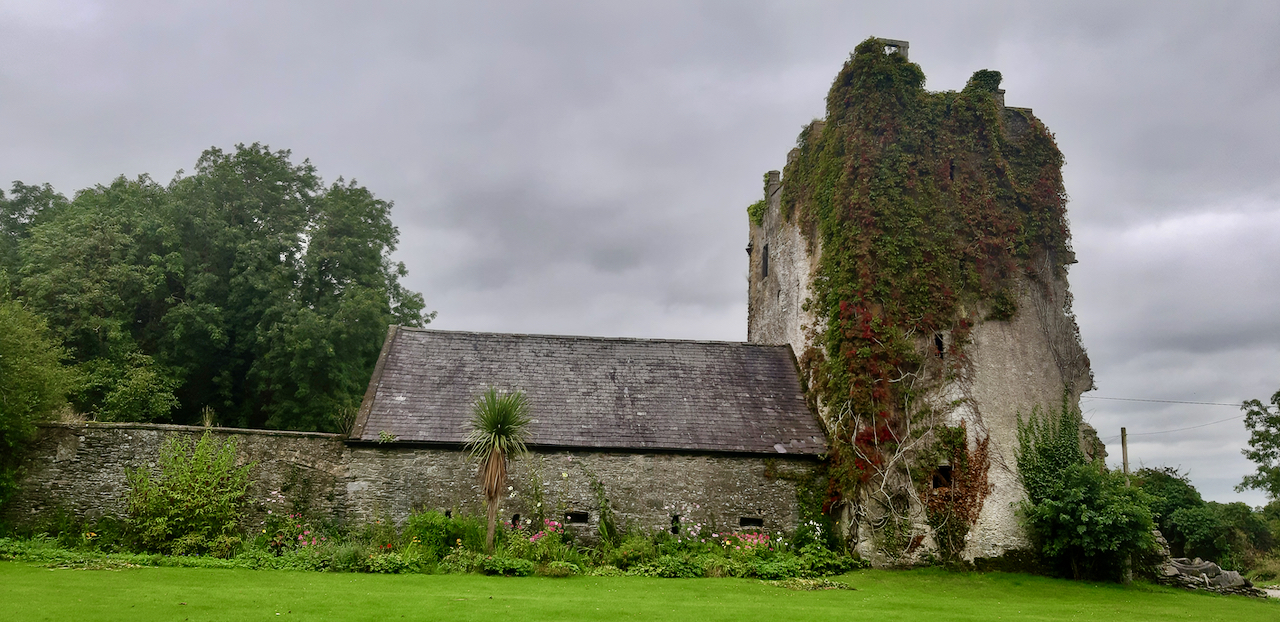
Blackhall Castle was constructed by the Eustace family. The Eustaces of Castlemartin, County Kildare, nearby, were a branch of the “old English” FitzEustace family who held the title of Baron Baltinglass. In the online introduction to an article published in 1955, “The Eustace Family & Their Lands in County Kildare,” by Major-General Sir-Eustace F. Tickell with additions by Ronald F. Eustice [Tickell’s article as published in the Journal of the County Kildare Archaeological Society Volume XI1I, No. 6 (1955)], Ronald Eustice describes the Eustace family’s importance in Irish history:
“[The story of the Eustace family] is a story closely linked with Irish history since the fourteenth century, the story of the birth of a great family and of its gradual disappearance from the County in the storms that have passed through Ireland during the last five-hundred years.
“This was a family often divided against itself by deeply- held religious differences and by divergent political loyalties, a family whose important members so often chose the losing side: It was for a time perhaps the most powerful in Kildare (except of course the FitzGeralds), with lands scattered from Confey in the north to beyond the county boundary in the south; from the Dublin and Wicklow mountains in the east to Athy and Newbridge in the west. The triangle containing Naas, Ballymore Eustace and Old Kilcullen was almost one large family estate:
“Criche-Eustace or Cry-Eustace it was called. Their castles, especially those at Ballymore Eustace, Harristown, Castlemartin and Clongowes Wood, guarded the Pale for several centuries, and only fell at last to the guns of Ormonde and Cromwell. It was rare for a jury of county gentlemen to contain no Eustace, and on at least one occasion they formed a majority upon a panel of twelve… The family produced two Lords Deputy, three Lords Chancellor, two Lords Treasurer and the High Sheriff of Kildare on forty-five occasions. With a few notable exceptions they have now almost disappeared from Kildare, and their name has become a rare one in Ireland itself.” [1]

We drove up the wooded driveway to the castle, which has a later building attached, and is next to a beautiful old country house, now belonging to Jeffrey & Naomi White. The driveway passed the castle and entered a yard bordered by a fine stone wall. From here we were able to approach the back of the castle for a closer look.


We were greeted by a pair of dogs, and Naomi emerged from the house after them. She was very kind and welcoming, and after telling us a little about the ruin, invited us in to her house to tell us a bit more!
When Jeffrey and Naomi purchased the house, many years ago, the ruin still had its four walls. It was when they were away on a trip to Australia in 1999, leaving their property in the hands of a tenant who lived in the small cottage beside the ruin, that half of the castle came crashing to the ground. A severe storm caused a structural subsidence resulting in the complete collapse of the East section and parts of the North and South walls. [2] A deep loud rumble preceded the fall, and the dogs barked, as if they knew something momentous and disasterous was about to occur. Suddenly, nearly three sides of this huge ancient stone edifice tumbled to the ground, casting its giant rocks into the yard below. Fortunately nobody was injured and the cottage next door, sheltering the terrified tenant, remained unharmed, as did the centuries old farmhouse.
Naomi showed us pictures of the castle before the fall, as it stood when they first acquired the property – see the top photograph in Naomi’s collage:
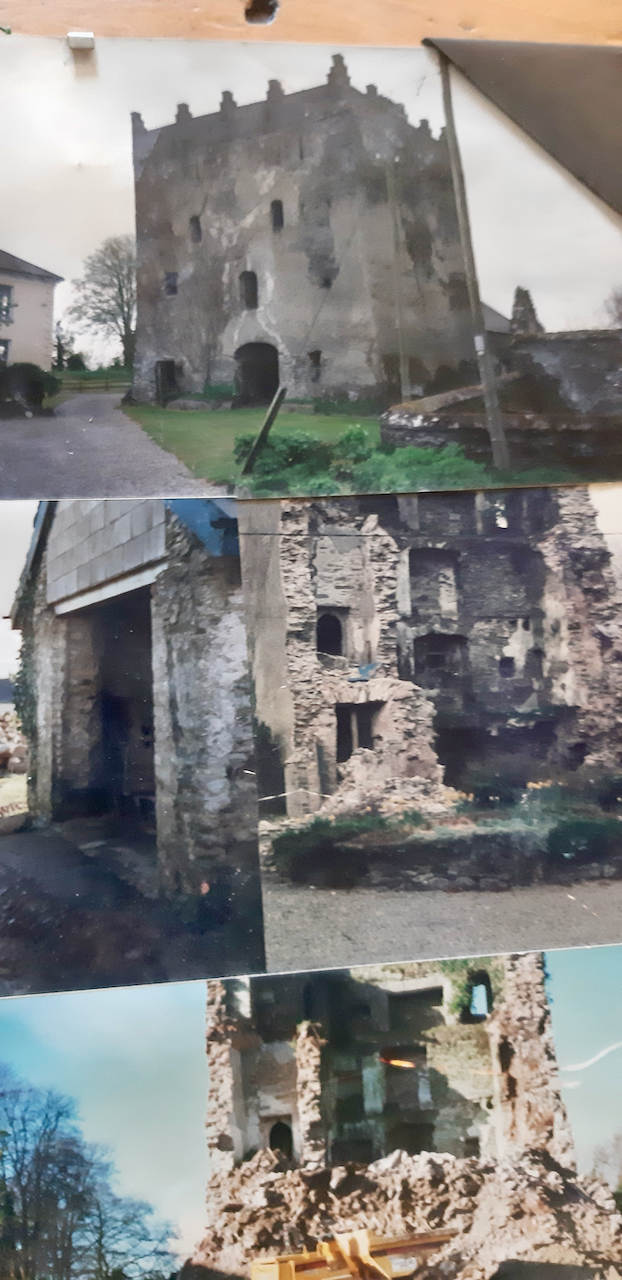

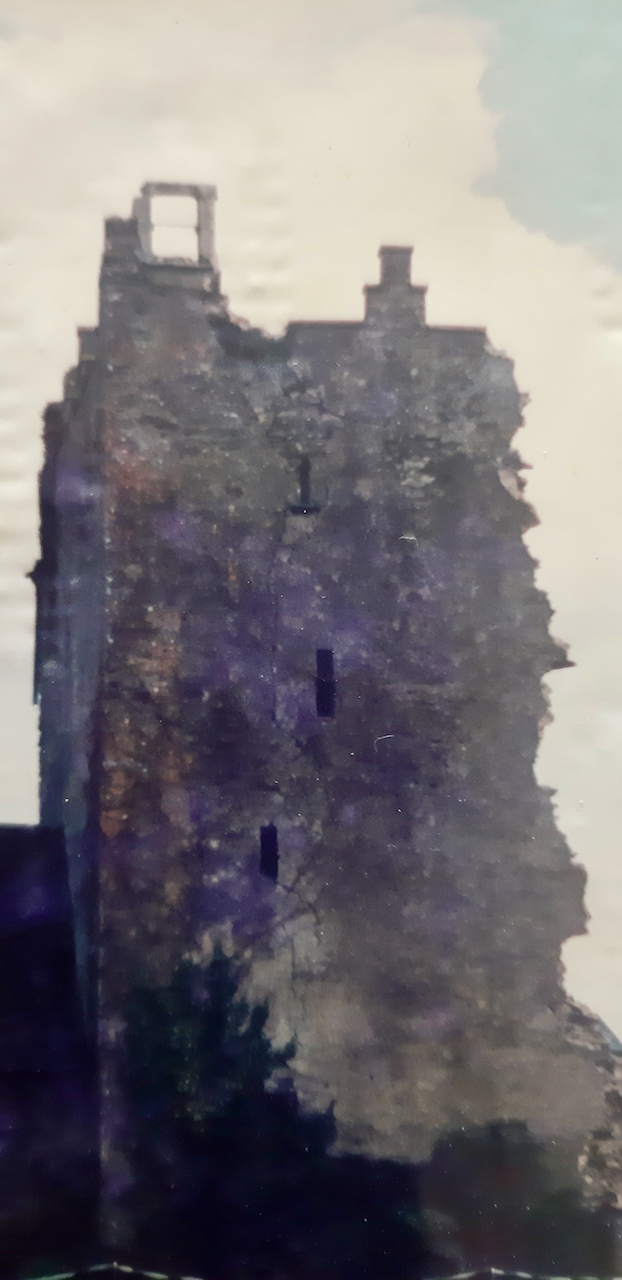
The castle now existed as a one-sided shell next to an enormous heap of stones and rubble. Fortunately, when the Whites began to clear the rubble, they found the Sheelagh-na-Gig, the ancient fertility symbol which appears lewd to our modern eyes, intact. The figure had been inserted originally above the door frame of the castle. It has now been attached back on to the remains of the castle.

Naomi has an informative poster of Sheelagh-na-gigs in Britain and Ireland, which includes her Sheelagh-na-gig:
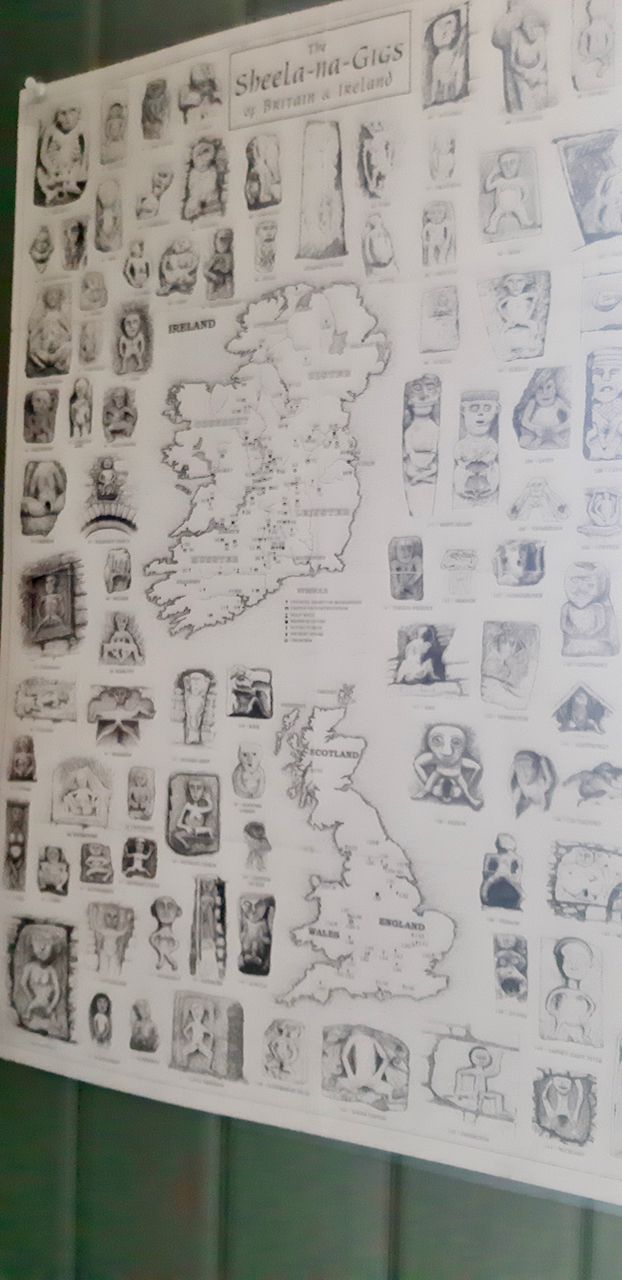
The remains of the castle have been made secure, which cost tens of thousands of euro, undertaken by the Whites with the help of a government grant. There is still much work to be done. Clearing the rubble was a massive task. The stone walls around the yard were built by an expert using some of the castle stones.
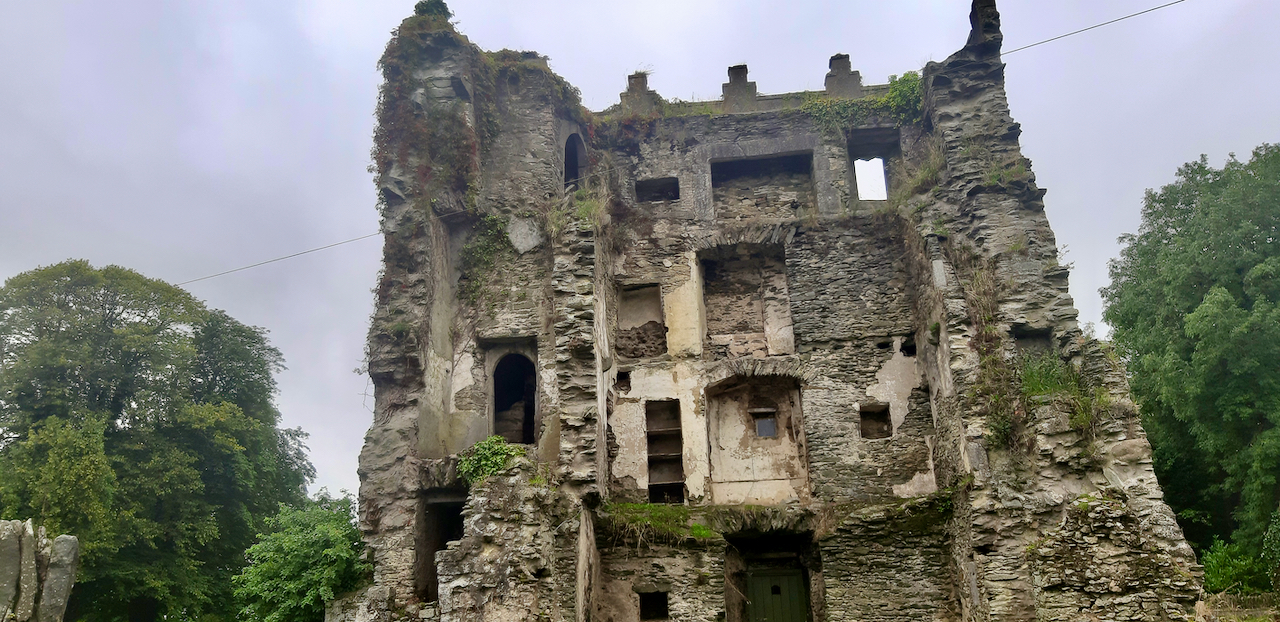
One can see where the floors of the castle were situated, the thickness of the walls, and the windows and fireplaces. I was particularly thrilled to see the intact round staircase, although we could not climb it, for safety reasons.
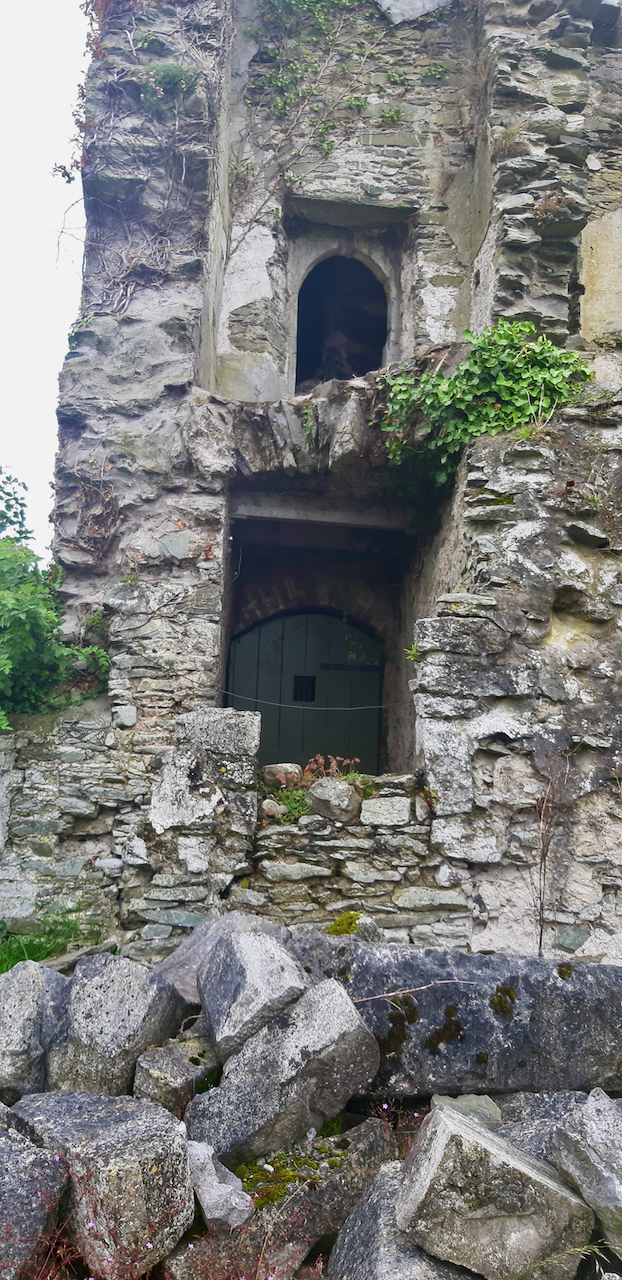

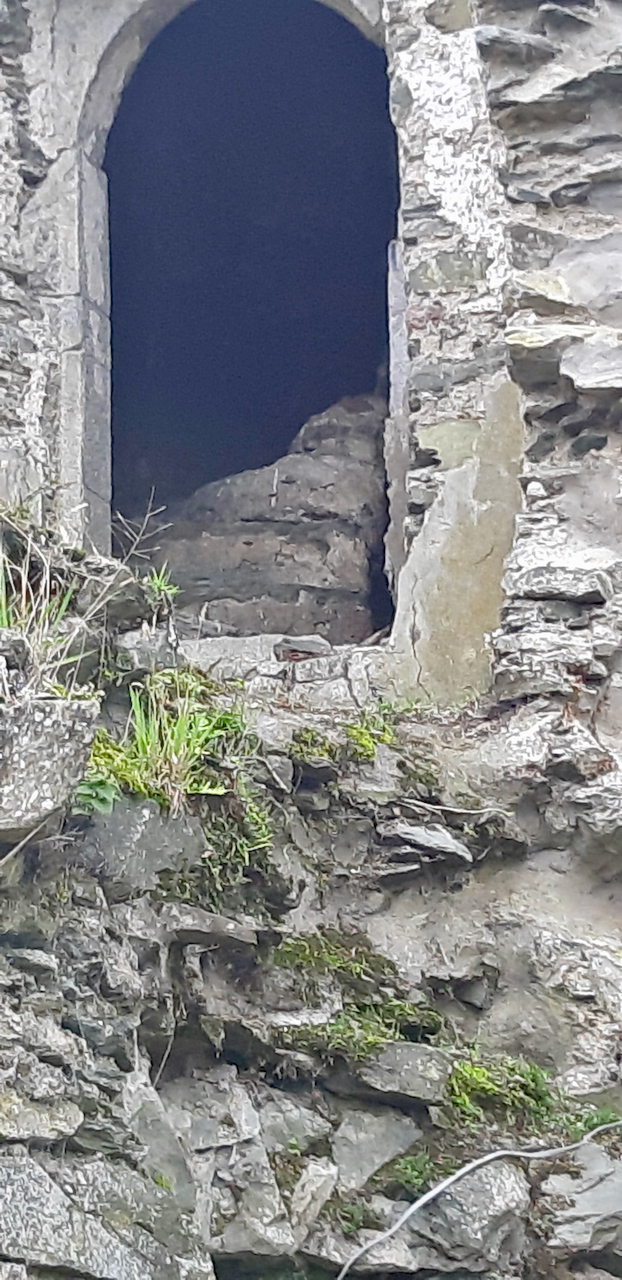
The Eustace family, according to Ronald Eustice, were a junior branch of the Le Poer family, whom I came across in my trip to Waterford, in Curraghmore (and mention of them in Salterbridge, in relation to Powerscourt, another Section 482 property). Four brothers Le Poer, of Norman origin, landed in Ireland with Henry II in 1171, and were granted lands in Ossory (Waterford). The stag with the crucifix between its antlers that tops Curraghmore is related to Saint Eustachius, a Roman centurion of the first century who converted to Christianity when he saw a miraculous stag with a crucifix between its antlers. This saint, Eustace, was probably the Patron Saint of the Le Poers since their family crest is the St. Eustace stag. I did not realise that St. Eustace is also the patron saint of Newbridge College in Kildare, where my father attended school and where for some time in the 1980s and 90s my family attended mass!

The Eustace line of the Le Poer family are descended from Eustace le Poer, Baron of Kells and a Justice Itinerant in 1285. I’m familiar with the term “Justice Itinerant” as a Robert Bagod, whom I hope is my ancestor, also served in this position in 1274. It was a judge who had to travel to courts in various parts of the country. Robert Bagod ended up living in Limerick. According to the article, Eustace le Poer’s son Arnold took the name FitzEustace, which changed to Eustace soon after the introduction of surnames in 1465. [see 1] Ronald Eustice writes of the move of the Eustace ancestors into County Kildare:
“By 1317, Arnold FitzEustace Le Poer certainly owned Castlemartin and the neighbouring townlands of Kilcullen, Brannockstown and Nicholastown, all just south of the Liffey. We also know that a FitzEustace was settled at Castlemartin before 1330; perhaps he was the Robert FitzEustace who was Lord Treasurer of Ireland in l 327.
We can thus assume with a fair degree of certainty that the Eustace estates in County Kildare originated at least as early as the start of the fourteenth century, (they had been granted lands near Naas in 1355) and were based upon the family stronghold of Castlemartin at the great bend in the Liffey, and that this had been built by a member of a junior branch of the powerful Le Poer family from Waterford, who had been granted or had seized lands in Kildare. One of these FitzEustaces founded the Dominican Priory at Naas in 1356, with its church dedicated to St. Eustachius.”
Ronald Eustice continues:
“Calverstown was occupied by the Eustaces at a very early date when they built their Blackhall Castle south of the present village. … In 1484 and again in 1493, a Richard Eustace of Kilgowan (just east of Calverstown) was High Sheriff.
“Both Calverstown and Gormanstown were owned by the Viscounts Baltinglass, and Roland [c. 1505-1578], later the 2nd Viscount, lived at the latter while his father was alive and occupying Harristown. At this time Calverstown was leased to a William Eustace, a juror in 1536. Both Calverstown (which contained “two castles prostrate”) and Gormanstown were forfeited after the Baltinglass rebellion, but Calverstown was re-granted to John ([Eustace] son of William of Castlemartin), with Harristown and Rochestown, and this grant was confirmed to his son Maurice in 1627.”

I like making the connection to Harristown, which we had visited earlier in the day! Ron Eustice tells us that Sir Maurice Eustace gave Calverstown to his daughter Mary (d. 1678), either at the time of her marriage to Sir Richard Dixon, or upon his death. Calverstown passed to their son, Robert Dixon, later Colonel, and M.P. for Harristown from 1703-1713. On his death in 1725 it passed to his sister Elizabeth, who had married Kildare Borrowes, 3rd Baronet of Giltown, M.P. for Harristown in the Irish House of Commons in 1721. Their property, which would have included Blackhall Castle, had to be sold in 1747, however, to pay debts. Eustice notes that nothing remains of the occupation of Eustaces in either of their estates except Blackhall Castle. Wikipedia states that Sir Kildare Borrowes lived in Barretstown Castle, which could be why he was able to sell Blackhall. I’m not sure who owned (and perhaps occupied) Blackhall after that, before the Whites.
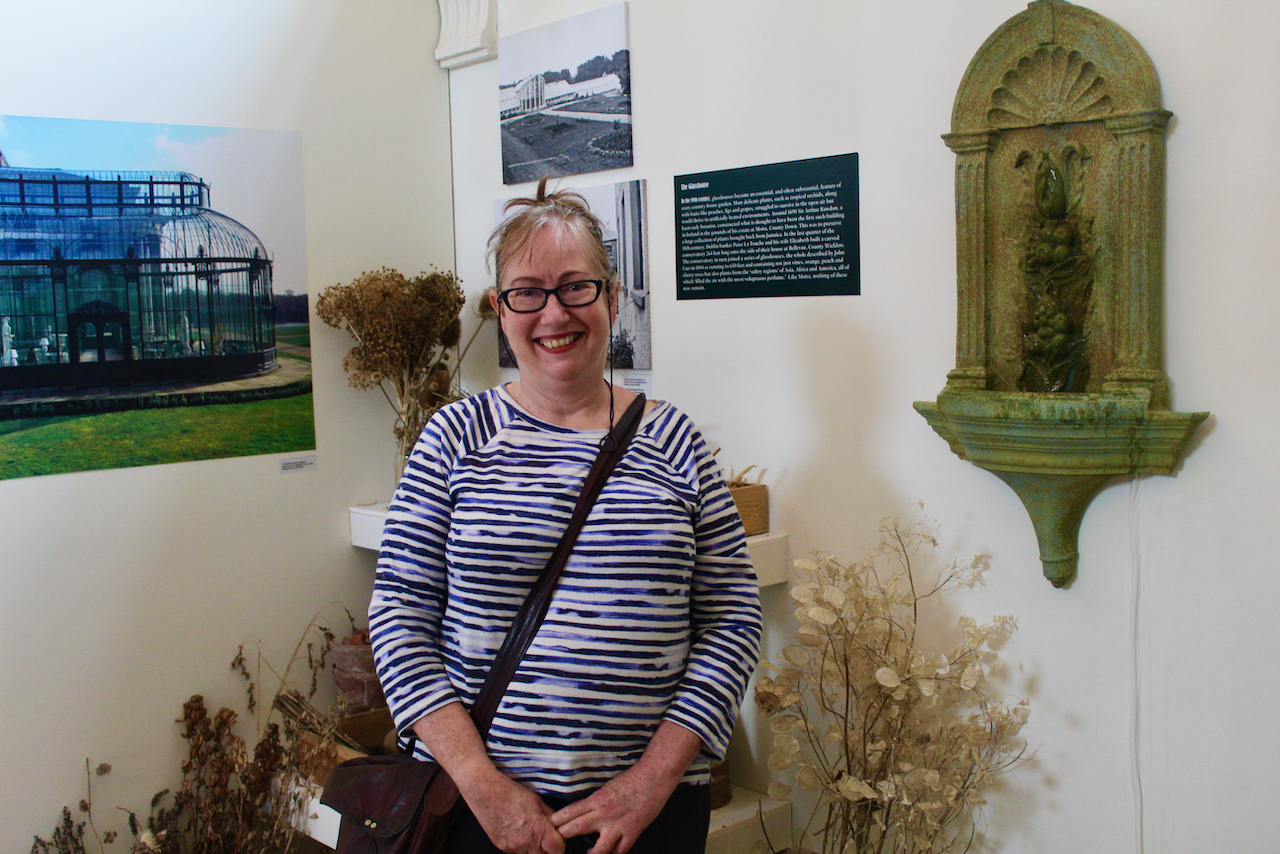
Donation
Help me to fund my creation and update of this website. It is created purely out of love for the subject and I receive no payment so any donation is appreciated! For this entry I paid for petrol to drive to our destination from Dublin.
€10.00
[1] http://www.roneustice.com/Family%20History/IrishFamiliessub/Kildare.html
[2] http://irelandinruins.blogspot.com/2014/09/blackhall-castle-co-kildare.html